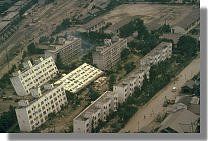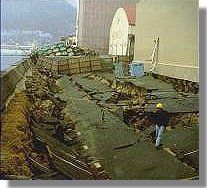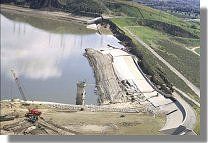Description
|
Liquefaction is a phenomenon in which the
strength and stiffness of a soil is reduced by earthquake shaking or
other rapid loading. Liquefaction and related phenomena have been
responsible for tremendous amounts of damage in historical earthquakes
around the world.
Liquefaction occurs in saturated soils, that
is, soils in which the space between individual particles is
completely filled with water. This water exerts a pressure on the soil
particles that influences how tightly the particles themselves are
pressed together. Prior to an earthquake, the water pressure is
relatively low. However, earthquake shaking can cause the water
pressure to increase to the point where the soil particles can
readily move with respect to each other.
|
Click
on the picture to start animation.
Schematic behavior of sand grains in a soil deposit during
liquefaction. The blue column represents the pore water pressure.
Here is an MPEG version (222 Kb)of the animation.
|
|
|
|
Earthquake shaking often triggers this increase in water pressure,
but construction related activities such as blasting can also cause an
increase in water pressure.
|
|
 When liquefaction occurs, the strength of the soil
decreases and, the ability of a soil deposit to support foundations
for buildings and bridges is reduced as seen in the photo
(SC) of the overturned apartment
complex buildings in Niigata in 1964.
When liquefaction occurs, the strength of the soil
decreases and, the ability of a soil deposit to support foundations
for buildings and bridges is reduced as seen in the photo
(SC) of the overturned apartment
complex buildings in Niigata in 1964.
|
The type of ground failure shown above
can be simulated in the laboratory,as seen in the video.
Click on the picture or on the
play button to start video.
Here is an MPEG
version (298 Kb) of the video.
|
|
|


|
Liquefied soil also exerts higher pressure
on retaining walls,which can cause them to tilt or slide. This movement can
cause settlement of the retained soil and destruction of structures on the
ground surface (left, GH)
Increased water pressure can also trigger landslides and cause the collapse
of dams. Lower San Fernando dam
(left, SC) suffered an
underwater slide during the San Fernando earthquake, 1971. Fortunately, the
dam barely avoided collapse, thereby preventing a potential disaster of flooding
of the heavily populated areas below the dam.
|
|

|





